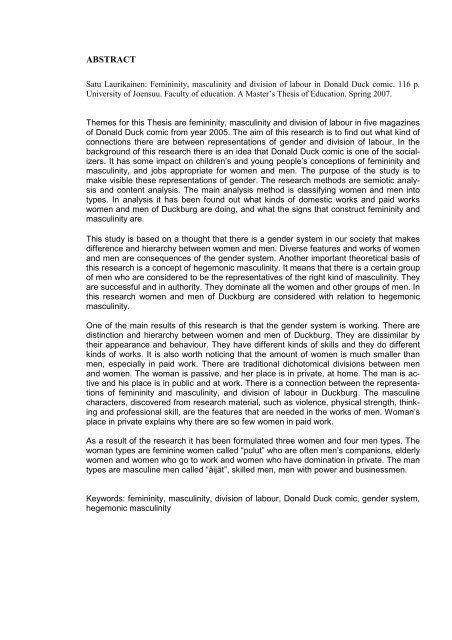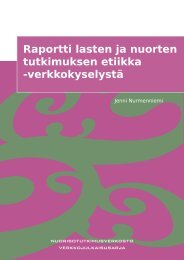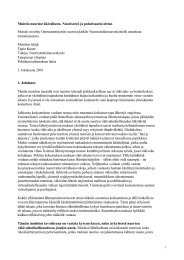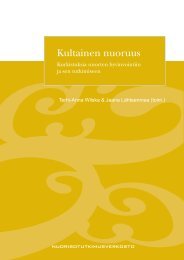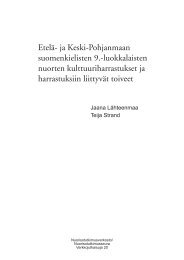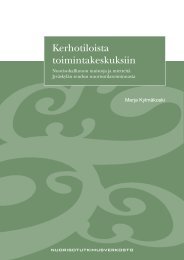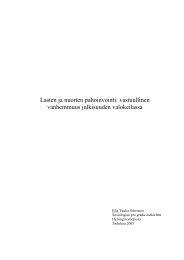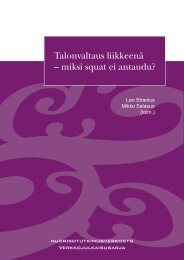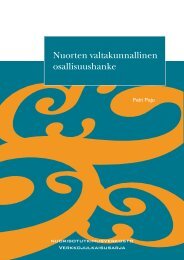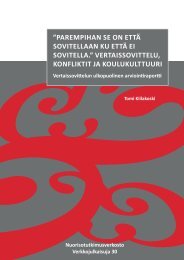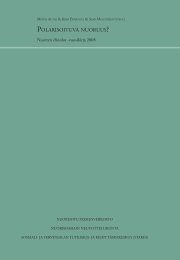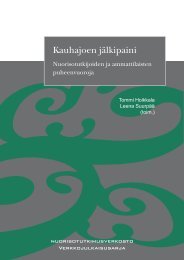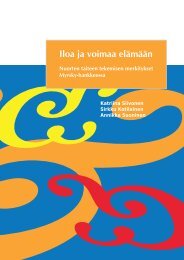Satu Laurikainen: âOdota vain, pulu. Näet vieressäsi tämän
Satu Laurikainen: âOdota vain, pulu. Näet vieressäsi tämän
Satu Laurikainen: âOdota vain, pulu. Näet vieressäsi tämän
Create successful ePaper yourself
Turn your PDF publications into a flip-book with our unique Google optimized e-Paper software.
ABSTRACT<strong>Satu</strong> <strong>Laurikainen</strong>: Femininity, masculinity and division of labour in Donald Duck comic. 116 p.University of Joensuu. Faculty of education. A Master’s Thesis of Education. Spring 2007.Themes for this Thesis are femininity, masculinity and division of labour in five magazinesof Donald Duck comic from year 2005. The aim of this research is to find out what kind ofconnections there are between representations of gender and division of labour. In thebackground of this research there is an idea that Donald Duck comic is one of the socializers.It has some impact on children’s and young people’s conceptions of femininity andmasculinity, and jobs appropriate for women and men. The purpose of the study is tomake visible these representations of gender. The research methods are semiotic analysisand content analysis. The main analysis method is classifying women and men intotypes. In analysis it has been found out what kinds of domestic works and paid workswomen and men of Duckburg are doing, and what the signs that construct femininity andmasculinity are.This study is based on a thought that there is a gender system in our society that makesdifference and hierarchy between women and men. Diverse features and works of womenand men are consequences of the gender system. Another important theoretical basis ofthis research is a concept of hegemonic masculinity. It means that there is a certain groupof men who are considered to be the representatives of the right kind of masculinity. Theyare successful and in authority. They dominate all the women and other groups of men. Inthis research women and men of Duckburg are considered with relation to hegemonicmasculinity.One of the main results of this research is that the gender system is working. There aredistinction and hierarchy between women and men of Duckburg. They are dissimilar bytheir appearance and behaviour. They have different kinds of skills and they do differentkinds of works. It is also worth noticing that the amount of women is much smaller thanmen, especially in paid work. There are traditional dichotomical divisions between menand women. The woman is passive, and her place is in private, at home. The man is activeand his place is in public and at work. There is a connection between the representationsof femininity and masculinity, and division of labour in Duckburg. The masculinecharacters, discovered from research material, such as violence, physical strength, thinkingand professional skill, are the features that are needed in the works of men. Woman’splace in private explains why there are so few women in paid work.As a result of the research it has been formulated three women and four men types. Thewoman types are feminine women called “<strong>pulu</strong>t” who are often men’s companions, elderlywomen and women who go to work and women who have domination in private. The mantypes are masculine men called “äijät”, skilled men, men with power and businessmen.Keywords: femininity, masculinity, division of labour, Donald Duck comic, gender system,hegemonic masculinity


